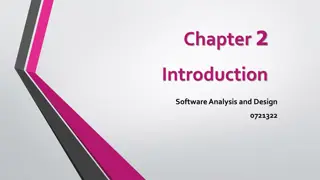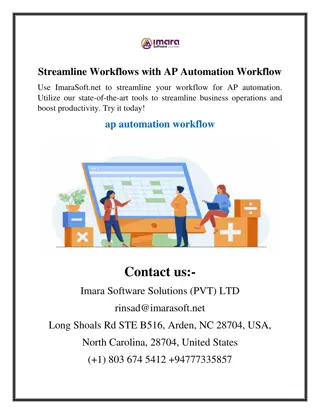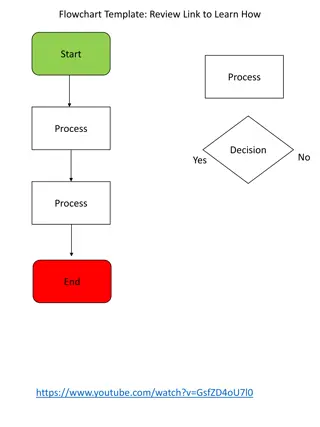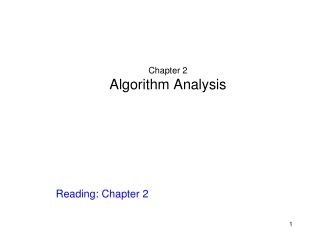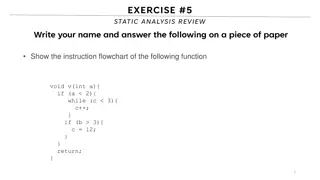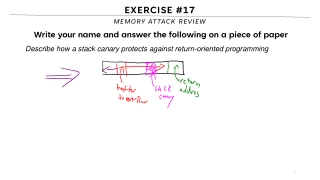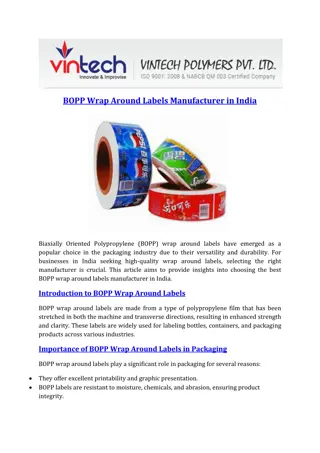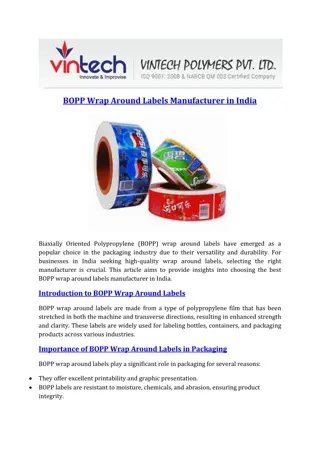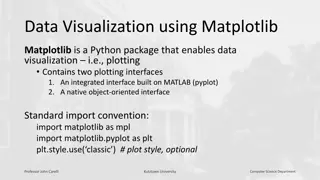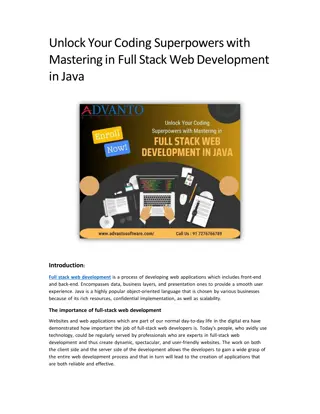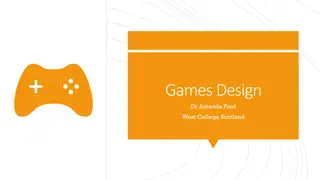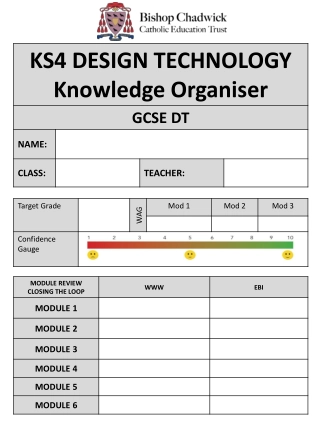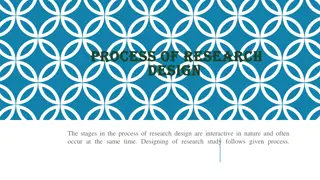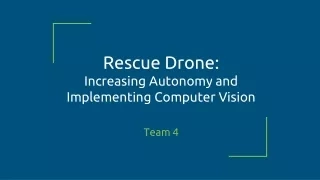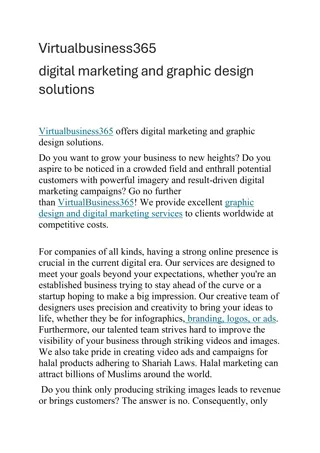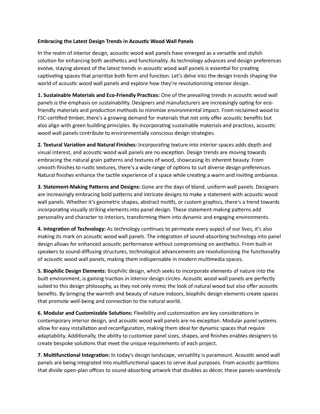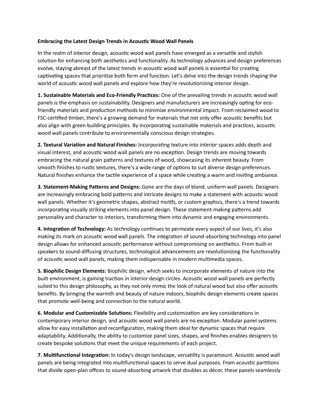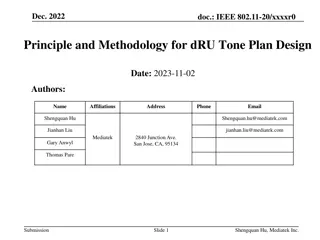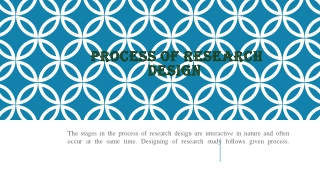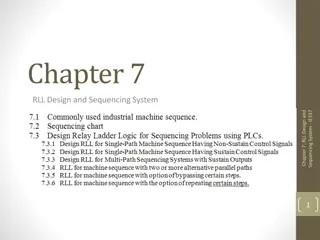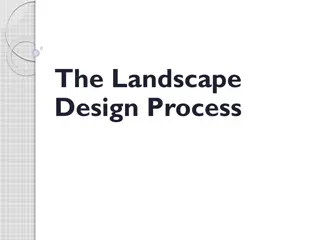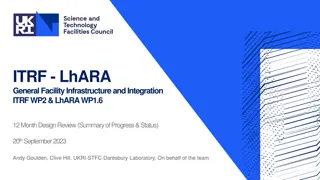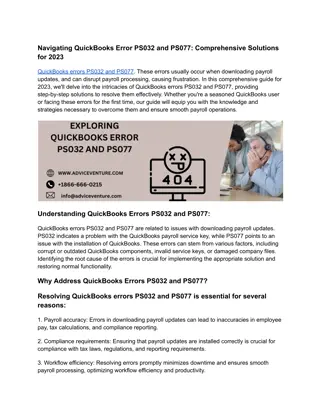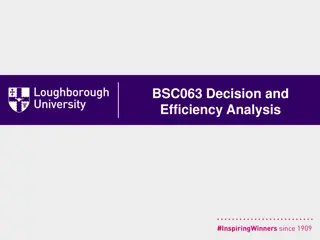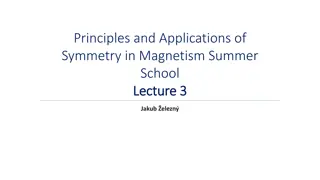Object-Oriented Analysis and Design Workflow
Object-Oriented Analysis (OOA) is a crucial step in software development to produce a logical model of the system's functionality. It involves requirements analysis, use case analysis, and use case realization to identify classes, responsibilities, attributes, and associations. The process includes analyzing use case descriptions, distributing behaviors to classes, ensuring consistency in the analysis model, and implementing use cases through class design. Collaboration, communication, and class diagrams play key roles in visualizing the system's design and interactions.
Object-Oriented Analysis and Design Workflow
PowerPoint presentation about 'Object-Oriented Analysis and Design Workflow'. This presentation describes the topic on Object-Oriented Analysis (OOA) is a crucial step in software development to produce a logical model of the system's functionality. It involves requirements analysis, use case analysis, and use case realization to identify classes, responsibilities, attributes, and associations. The process includes analyzing use case descriptions, distributing behaviors to classes, ensuring consistency in the analysis model, and implementing use cases through class design. Collaboration, communication, and class diagrams play key roles in visualizing the system's design and interactions.. Download this presentation absolutely free.
Presentation Transcript
Chapter 4 Object-Oriented Analysis Software Analysis and Design 0721322 1
Analysis workflow The purpose of requirements analysis is to produce an analysis or a logical model of the desired system. The analysis model is an abstraction or a generalization of the design. It omits most of the details of how the system works and provides an overview of the system's functionality. 2
Use case Analysis Purpose To identify the classes which perform a use case s flow of events. To distribute the use case behavior to those classes, using use-case realizations. To identify the responsibilities, attributes and associations of the classes. Input Artifacts Glossary Supplementary Specifications Use-Case Model Resulting Artifacts Analysis Model o Use case collaborations o Communication diagrams o Use case class diagrams o Analysis class diagram 3
Use Case Analysis Steps Supplement the Descriptions of the Use Case We must first review the use-case descriptions, as developed in the Requirements workflow. For each use case: o Find Classes from Use-Case Behavior o Distribute Use-Case Behavior to Classes The use case flows of events will be studied, analysis classes will be identified, and use case responsibilities allocated to those analysis classes For each resulting analysis class o Describe Responsibilities o Describe Attributes and Associations o Qualify Analysis Mechanisms Unify Analysis Classes We need to make sure that our developed analysis model is consistent. 4
A First Step Towards Executables Use Cases Analysis Classes Design Classes Source Code Exec 5 Use-Case Analysis
Use case realization A use-case realization describes how a particular use case will be implemented, in terms of collaborating objects. A use-case realization specifies what classes must be built, how they collaborate (relationships, dependencies ), and the messages passed between objects necessary to implement each use case. Class Diagrams can be used to describe the classes and relationships that participate in the realization of the use case. These diagrams model the context of the use-case realization. 6
Use case realization Interaction Diagrams (sequence and/or collaboration diagrams) can be used to describe how the use case is realized in terms of collaborating objects. It is recommended that collaboration diagrams are used during Analysis and that sequence diagrams are used during Design. The use-case realization can be used by class designers to understand the class s role in the use case and how the class interacts with other classes. This information can be used to determine/refine the class responsibilities and interfaces. 7
Use case realization Use Case Model Design Model Add a new campaign <<realizes>> :Customer Use Case Use Case Realization Sequence Diagrams Collaboration Diagrams Use Case Realization Documentation 8 Class Diagrams
Supplement the Descriptions of the Use Case The first step of use case analysis The purpose of Supplement the Descriptions of the Use-Case is to capture additional information needed in order to understand the required internal behavior of the system that may be missing from the use-case description written for the customer of the system. This information will be used as input the rest of the steps in Use Case Analysis and is used to assist in the allocation of responsibility. 9
Supplement the Descriptions of the Use Case Sometimes the description of the use case is not sufficient for identifying analysis classes and their objects. Remember, customer doesn t care about the inside of the system, so many details may have been left out leaving the use case description like a black box. The system retrieves and displays a list of current course offerings from the course catalog legacy database given specific parameters, such as... The system displays a list of course offerings. To find objects that perform the use cases, we may need white box descriptions that is, what does the system do from an internal perspective. From this, some objects may be identified. 10 Many times we do not have enough detail.
Find Classes from Use-Case Behavior Finding a candidate set of analysis classes is the first step in the transformation of the system from a mere statement of required behavior to a description of how the system will work. The technique described here uses three different perspectives of the system to drive the identification of candidate classes. The three perspectives are that of the boundary between the system and its actors, the information the system uses, and the control logic of the system. The candidate set of analysis class includes : - Boundary class - Entity classes - Control classes The complete behavior of a Use-Case has to be distributed to analysis classes. 12
Find Classes from Use-Case Behavior Analysis class modeling represents an early conceptual model for things in the system which have responsibilities and behaviors . Analysis classes are used to capture a first-draft , rough-cut of the object model of the system. Analysis classes handle primary functional requirements, interface requirements, and some control <<boundary>> <<control>> <<boundary>> 13 <<entity>> <<entity>>
Analysis Classes Three things likely to change in a system: The boundary between the system and its actors (interfaces ) The information a system uses (data) The control logic of the system (who does what) We isolate the different kinds of analysis classes Each of these has a set of responsibilities The distinction between these classes is used in analysis but changes in design or becomes less of an issue We transform these analysis classes into design artifacts / design entities to accommodate the problem domain representations in a solutions space. 14
Boundary Class A boundary class is a class within the analysis model used to model the interaction between the system and its actors. The following aspects of the interaction are captured on boundary classes: coordinating the actor's behavior with the "internals" of the system; receiving input from the actor to the system, e.g., information or requests; providing output from the system to the actor, e.g., stored information or derived results. 15
Boundary Class Types of Boundary Classes User interface classes classes that facilitate communication with human users of the system Menus, forms, etc. System interface classes classes which facilitate communications with other systems. These boundary classes are responsible for managing the dialogue with the external system, like getting data from an existing database system or flat file Device Interface Classes provide an interface to devices which detect external events like a sensor There is at least one boundary class for each use-case actor-pair. 16
Boundary Class <<boundary>> <<control>> <<boundary>> Customer External Database?? <<boundary>> <<entity>> <<entity>> Actors can only communicate with boundary classes. . 17
Boundary class: User Interface Class Boundary classes are chosen in Elaboration Phase of development and are typically at a high level. For example, you may model a window but not model each of its dialogue boxes and buttons. At this point, you are documenting the user interface requirements, not implementing the interface. Sketches, or screens from a user-interface prototype, may have been used during the Requirements workflow to illustrate the behavior and appearance of the boundary classes. 18
Example: User Interface Class Register for Courses MaintainScheduleForm (from Student Interface) 19
Boundary Class: System Interface Class A boundary class which communicates with an external system is responsible for managing the dialogue with the external system; it provides the interface to that system for the system being built. During design, these classes are refined to take into consideration the chosen communication protocols. If the interface to an existing system is already well-defined, the responsibilities should be derived directly from the interface definition. 20
Example: System Interface Class Close Registration Finance System FinanceSystem (from Finance System) 21
Boundary Class: Device Interface Class The system may contain elements that act as if they were external (change value spontaneously without any object in the system affecting them), such as sensor equipment. If the device is represented as an actor in the use-case model, it is easy to justify using a boundary class to intermediate communication between the device and the system. If the use-case model does not include these "device-actors", now is the appropriate time to add them, updating the Supplementary Descriptions of the Use Cases where appropriate. For each "device-actor", create a boundary class to capture the responsibilities of the device or sensor. If there is a well-defined interface already existing for the device, make note of it for later reference during design. 22
Example: Device Interface Class BarCodeReader 23
Entity Class An entity class models information and associated behavior that is generally long lived. This type of class may reflect a real-world entity or it may be needed to perform tasks internal to the system. They are typically independent of their surroundings; that is, they are not sensitive to how the surroundings communicate with the system. Many times, they are application independent, meaning that they may be used in more than one application. The main responsibilities of entity classes are to store and manage information in the system. Entity classes typically are found early in the Elaboration Phase. They are often called "domain" classes since they usually deal with abstractions of real-world entities. 24
The Role of an Entity Class Entity objects are usually not specific to one use-case realization; sometime, an entity object is not even specific to the system itself. <<boundary>> <<control>> <<boundary>> <<boundary>> <<entity>> <<entity>> Store and manage information in the system 25
The Role of an Entity Class Entity objects (instances of entity classes) are used to hold and update information about some phenomenon, such as an event, a person, or some real-life object. They are usually persistent, having attributes and relationships needed for a long period, sometimes for the life of the system. An entity object is usually not specific to one use-case realization; sometimes, an entity object is not even specific to the system itself. The values of its attributes and relationships are often given by an actor. An entity object may also be needed to help perform internal system tasks. Entity objects can have behavior as complicated as that of other object stereotypes. However, unlike other objects, this behavior is strongly related to the phenomenon the entity object represents. Entity objects are independent of the environment (the actors). 26
Finding Entity Classes Use use-case flow of events and domain model and glossary as inputs. The more of these you have the better you are! Traditional, filtering nouns approach (but I d recommend using classes from the domain model as a starting place, if available) Underline noun clauses in the use-case flow of events Remove redundant candidates Remove vague candidates Remove implementation constructs Remove attributes (save for later) Remove operations 27
Example: Candidate Entity Classes Register for Courses (Create Schedule) <<entity>> Student CourseOffering A person enrolled in classes at the university A specific offering for a course including days of week and times Schedule The courses a student has selected for current semester 28
Example: Candidate Entity Classes Sometimes there is a need to model information about an actor within the system. This is not the same as modeling the actor (actors are external by definition). For example, a course registration system maintains information about the student which is independent of the fact that the student also plays a role as an actor of the system. This information about the student that is stored in a Student class is completely independent of the actor role the student plays; The Student class (entity) will exist whether or not the student is an actor to the system. 29
Example: Entity Classes Course - A class offered by the university. CourseOffering - A specific offering for a course, including days of the week and times. Student - A person enrolled in classes at the university. Professor - A person teaching classes at the university. Schedule - The courses a student has enrolled in for the current semester. Separation of concerns Abstraction 30
What is a Control Class? Use-case behavior coordinator One control class per use case The control class is responsible for the flow of events in the use case. <<control>> Analysis class stereotype Use Case Use-case dependent, Environment independent 31
The Role of a Control Class <<boundary>> <<control>> <<boundary>> Customer <<boundary>> <<entity>> <<entity>> Coordinate the use-case behavior 32
The Role of a Control Class A control class is a class used to model control behavior specific to one or a few use cases. Control objects (instances of control classes) often control other objects, so their behavior is of the coordinating type. The behavior of a control object is closely related to the realization of a specific use case. In many scenarios, you might even say that the control objects "run" the use-case realizations. However, some control objects can participate in more than one use-case realization if the use-case tasks are strongly related. Furthermore, several control objects of different control classes can participate in one use case. When the system performs the use case, a control object is created. Control objects usually die when their corresponding use case has been performed. 33
The Role of a Control Class Not all use cases require a control object. For example, if the flow of events in a use case is related to one entity object, a boundary object may realize the use case in cooperation with the entity object. You can start by identifying one control class per use-case realization, and then refine this as more use-case realizations are identified and commonality is discovered. Control classes can contribute to understanding the system because they represent the dynamics of the system, handling the main tasks and control flows. The addition of a control class per actor/use case pair is only an initial cut as analysis and design continues, control classes may be eliminated, split up, or combined. In the early stages of the Elaboration Phase, a control class is added for each actor/use case pair. 34
Example: Control Classes RegistrationController CloseRegistrationController MaintainStudentController MaintainProfessorController SelectCoursesToTeachController SubmitGradesController ReportCardController 35
Example : Objects and Classes in the ESU Course Registration Problem Classes extracted from Select Courses To Teach use case: We will look at the Add a Course Offering to Teach scenario, which is one of the subflows of the Select Courses to Teach use case. The main capability provided by this scenario is the ability for the professor to select a course offering to teach for a given semester. 1. Identify Boundary Classes A class containing all the options available to the Professor as stated in the use case is created to satisfy this need. This class is called ProfessorCourseOptions. Additionally, we can identify a class that deals with the addition of a new Course Offering for the Professor. This class is called AddACourseOffering. 2. Identify Entity Classes This scenario deals with Courses, their Course Offerings, and the Professor assignment. We can identify three entity classes: Course,CourseOffering, and Professor. 3. Identify Control Classes We will add one control class to handle the flow of events for the use case. This class is called ProfessorCourseManager. 36
Objects and Classes in the ESU Course Registration Problem .. cont Professor Select Courses to Teach Use Case Model Analysis Model ProfessorCourseOptions AddACourseOffering. Professor. CourseOffering Course ProfessorCourseManager. 37
Objects and Classes in the ESU Course Registration Problem .. cont Student Register for Courses Use Case Model Analysis Model MainForm RegistrationController MaintainScheduleForm Schedule CourseCatalogSystem 38
From Analysis Classes to Design Elements Analysis classes handle primarily functional requirements, and model objects from the "problem" domain; design elements handle non- functional requirements, and model objects from the "solution" domain. Throughout the design activities, analysis classes are refined into design elements (e.g., design classes, packages, subsystems etc.). In general, there is a many-to-many mapping between analysis classes and design elements: An analysis class can become one single class in the design model. An analysis class can become a part of a class in the design model. An analysis class can become an aggregate class in the design model. (Meaning that the parts in this aggregate may not be explicitly modeled in the analysis model.) 39
From Analysis Classes to Design Elements.. cont An analysis class can become a group of classes that inherits from the same class in the design model. An analysis class can become a group of functionally related classes in the design model (e.g., a package). An analysis class can become a subsystem in the design model . An analysis class can become a relationship in the design model. A relationship between analysis classes can become a class in the design model. Part of an analysis class can be realized by hardware, and not modeled in the design model at all. Any combination of the above are also possible. 40
Analysis Classes and the Architecture Layer 1 Layer 2 Layer 3 Once the analysis classes have been identified, they should be allocated to specific layers in the architecture. These layers are the initial layers defined during Architectural Analysis. This should be done here because the allowable dependencies between layers may affect the responsibilities allocated to the classes in the next step. 42
Distribute Use-Case Behavior to Classes Now we need to allocate responsibilities of the use cases to the analysis classes and model this allocation by describing the way the class instances collaborate to perform the use case in use-case realizations. A use-case realization- analysis is a collaboration within the analysis model that describe how a specific use case is realized and performed in terms of analysis classes and their interacting analysis objects. A use-case realization has a flow-of-events descriptions, class diagrams that depicts its participating analysis classes, and interaction diagrams that depict the realization of a particular flow of the use case in terms of analysis object interactions. The purpose of Distribute Use-Case Behavior to Classes is to: - Express the use-case behavior in terms of collaborating analysis classes. - Determine the responsibilities of analysis classes. 44
Distribute Use-Case Behavior to Classes ..cont Use Case Use-Case Realization 45
Guidelines Use analysis class stereotypes as a guide Boundary Classes (the Interface) Behavior that involves communication with an actor Entity Classes (Persistent Data) Behavior that involves the data encapsulated within the abstraction Control Classes (the Use Case flow of events) Behavior specific to a use case or part of a very important flow of events (continued) 46
Guidelines: Who has the data needed to perform the responsibility? Design options: One class has the data, put the responsibility with the data best case!!! Multiple classes have the data: Put the responsibility with one class and add a relationship to the other (a dependency relationship) Create a new class, put the responsibility in the new class, and add relationships to classes needed to perform the responsibility Put the responsibility in the control class, and add relationships to classes needed to perform the responsibility 47
Guidelines: Be careful when adding relationships -- all relationships should be consistent with the abstractions they connect. Don t just add relationships to support the implementation without considering the overall affect on the model. When a new behavior is identified, check to see if there is an existing class that has similar responsibilities, reusing classes where possible. Only when sure that there is not an existing object that can perform the behavior should you create new classes. 48
Collaboration Diagram The collaboration diagram should show interactions of the system with its actors (the collaborations should begin with an actor, since an actor always invokes the use case). If you have several actor instances in the same diagram, try keeping them in the periphery of the diagram. Interactions BETWEEN actors should NOT be modeled. By definition, actors are external, and are out of scope of the system being developed. Thus, you do not include interactions between actors in your system model. Let s look at how to distribute behavior to classes: 49
The Anatomy of Collaboration Diagrams Client Object Link Supplier Object :Client 1: PerformResponsibility :Supplier Message 50


